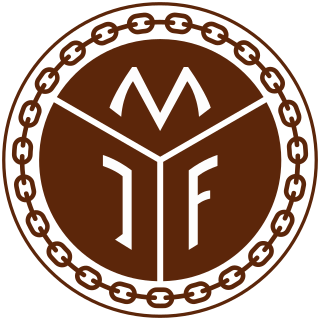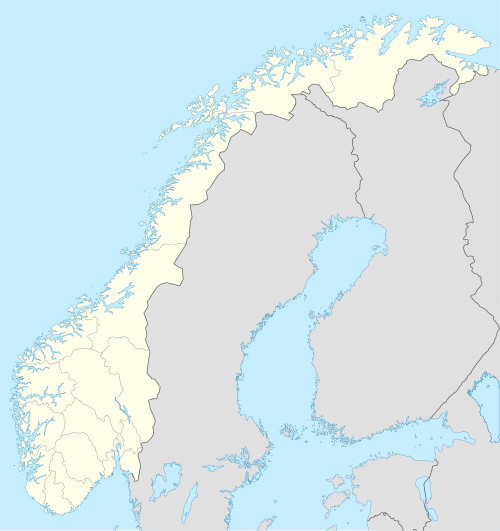The Norwegian First Division, also called 1. divisjon and OBOS-ligaen, is the second-highest level of the Norwegian football league system. Each year, the top finishing teams in the 1. divisjon are promoted to the Eliteserien, and the lowest finishing teams are relegated to 2. divisjon.
Norwegian reserve football teams compete at all levels of league football within the Norwegian football league system apart from the top two divisions, Eliteserien and 1. divisjon. The highest league these teams can currently enter is the 2. divisjon, set at the third tier of the league system. The reserve teams are attached to their first teams with a "2" suffix and must play in a lower league than the first team. Furthermore, if a club's first team plays in the 1. divisjon, the reserves team cannot play in the 2. divisjon either.

The Norwegian Third Division, also called Norsk Tipping-Ligaen, is the fourth highest division of the men's football league in Norway. Like the rest of the Norwegian football league system, the season runs from spring to autumn, running approximately from April to October. After the 2010 season, the league was reorganised, reducing the number of teams to 164 and halving the number of parallel sections from 24 to 12. After the 2016 season, the league was again reorganised, reducing the number of teams from 164 to 84, and halved the number of groups from twelve to six.
The 2015 2. divisjon was a Norwegian football third-tier league. The league consisted of 56 teams divided into 4 groups of 14 teams. The winners of the four groups were promoted to the 1. divisjon, while the bottom three teams in each groups were relegated to the 3. divisjon.
The 2017 2. divisjon was a Norwegian football third-tier league. The league consisted of 28 teams divided into 2 groups of 14 teams.
The 2018 2. divisjon was a Norwegian football third-tier league season. The league consisted of 28 teams divided into 2 groups of 14 teams.
The 2017 season of the 3. divisjon, the fourth highest association football league for men in Norway.
The 2019 2. divisjon was a Norwegian football third-tier league season. The league consisted of 28 teams divided into 2 groups of 14 teams.
The 2019 3. divisjon was a fourth-tier Norwegian football league season. The league consisted of 84 teams divided into 6 groups of 14 teams each and began on 13 April 2019.
Stord Idrettslag is a sports club located in Stord, Norway. The club was founded as Stord Turn og idrettslag on 30 March 1914, and today it has sections for athletics, basketball, gymnastics, handball, football, orienteering, volleyball, skiing, speed skating and swimming. The club formerly had a section for wrestling.
The 2020 2. divisjon was a Norwegian football third-tier league season. The league consisted of 28 teams divided into 2 groups of 14 teams. The groups were announced by the NFF on 7 December 2019.

Mjøndalen IF Fotball – commonly known as Mjøndalen IF, and Mjøndar'n or MIF – is the football department of Mjøndalen IF. Founded in 1910, the club is located in Mjøndalen, Viken, Norway. The team plays its home matches in the 4,350-capacity Consto Arena. Mjøndalen competes in Obos Ligaen, the second tier in the Norwegian football league system having been relegated from the Eliteserien at the end of the 2021 season.
The 2021 Norwegian First Division is a Norwegian second-tier football league season.
The 2021 Norwegian Second Division was a Norwegian football third-tier league season. The league consisted of 28 teams divided into 2 groups of 14 teams.
The 2021 3. divisjon was a fourth-tier Norwegian football league season. The league consisted of 84 teams divided into 6 groups of 14 teams each. The season began in early August 2021. All teams played 13 matches instead of the normal 26. Furthermore, all reserve teams were barred from promotion.
The 2022 Norwegian First Division is a Norwegian second-tier football league season.
The 2022 Norwegian Second Division was a Norwegian football third-tier league season. The league consisted of 28 teams divided into 2 groups of 14 teams.
The 2023 Norwegian Second Division was a Norwegian football third-tier league season. The league consists of 28 teams divided into two groups of 14 teams.
The 2022 Norwegian Third Division was a fourth-tier Norwegian football league season. The league consisted of 84 teams divided into 6 groups of 14 teams each. The season started on 9 April 2022 and ended on 23 October 2022. The league was played as a double round-robin tournament, where all teams played 26 matches.



